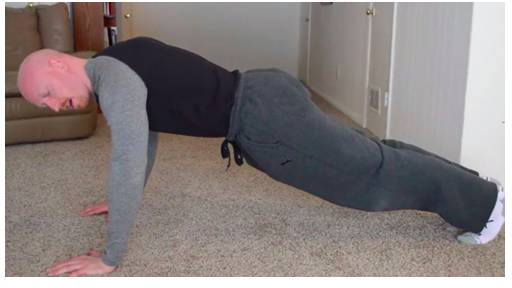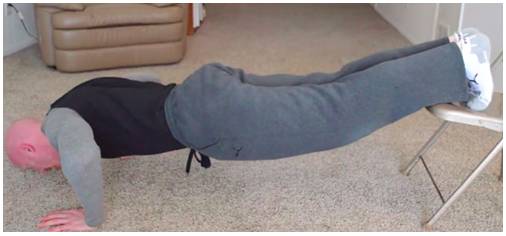Over the last several years, the popularity of bodyweight training has exploded. The American College of Sports Medicine ranked it as the number one fitness trend of 2015. It’s easy to see why. There are many benefits, including convenience, low cost, and enjoyment, to name just a few.
The Complexity of Bodyweight Training
Bodyweight training as a methodology has experienced little innovation as far as the general public is concerned. Most people see it simply as a combination of push ups, pull ups, and un-weighted squats. But bodyweight training can be much more than that.
There is a dynamic world of unique ways to manipulate an exercise to make it much more challenging and effective. Bodyweight exercise is not just a “finisher” exercise after the “real” weight lifting exercises are completed.
Push ups are a bodyweight exercise staple, but there are many variations of a single movement.
Why do so many people see bodyweight training as limited? Because the only variable they know how to adjust is number of repetitions. For example, at first a person’s goal might be to perform fifty push ups in a row. Once the person achieves that, then what’s next? Eighty, ninety, or 100 push ups?
This type of thinking is linear and limited. When, in fact, bodyweight exercises are extremely versatile and can help anyone build lean muscle and increase strength.
How to Manipulate Bodyweight Training
In this article, I’m going to teach you three methods I have been using for years. These methods will help you make bodyweight training more effective:
- Adjust the angle of the exercise
- Manipulate your body weight distribution
- Decrease speed during the eccentric
By applying each of the above techniques, you will be able to make any bodyweight exercise more challenging – and transform it from an endurance exercise (high reps) into a strength exercise (low reps). Let’s cover each one individually.
1. Adjust the Angle of the Exercise
In traditional lifting, angles are adjusted constantly to target different muscle fibers within the same muscle group. For example, flat bench press targets the middle portion of the chest, incline bench press targets the upper portion, and decline bench press targets the lower portion.
When you perform bodyweight exercises, angles can also be manipulated to target different regions of the same muscle group. For example, if you perform the normal push up, you target mostly the middle portion of the chest.

Traditional push ups target the middle portion of the chest.
When you place your feet on a chair or desk, therefore performing a decline push up, you target your upper chest.

Decline push ups shift the bodyweight burdon toward your upper chest.
If you elevate your upper body by placing your hands on a desk while doing a push up or (for those of you more advanced) use a dip bar or rings to perform dips, you will target the lower pecs.
Here are some more examples:
Shoulders:
- Pike Push Up – Targets Front Delts
- Handstand Push Up – Targets Middle Delts
- Bridge Push Up – Targets Rear Delt
Back:
- Traditional Pull Up – Targets Lats
- Narrow Grip Pull Up or Arching Pull Up – Targets Rhomboids
2. Manipulate Your Body Weight Distribution
As I said before, most people look at bodyweight-based training as linear. They simply try to increase the number of reps. But the distribution of your bodyweight while performing an exercise is another factor you can manipulate to make an exercise more challenging.
For every exercise you perform, think of how you can manipulate the distribution of your body weight to make the exercise harder.
For example, in a traditional push up, you typically distribute your weight evenly across both arms. Fifty percent of your upper body weight is in your right arm and fifty percent in your left.
But what if you were to shift more of your weight into one arm? Would it make the exercise harder? You bet.
By shifting more to one arm, you force the chest muscles to recruit more muscle fibers and thereby making the exercise harder – and more effective.
Uneven push ups recruit more muscle fibers in the chest than traditional push ups.
Doing push ups this way will allow you to fatigue within a lower rep range and help you build more lean tissue.
There are other body parts where distribution of body weight can be manipulated to your advantage, as well:
- While doing a pull up or chin up, you can put more weight into one arm to make the exercise more challenging.
- While doing dips, you can shift your weight and put more stress on one tricep.
- While doing bodyweight squats, you can shift your weight to one side and even eventually be able to perform a one-legged pistol squat.
For every exercise you perform, think of how you can manipulate the distribution of your body weight to make the exercise harder.
3. Decrease Speed During the Eccentric
This is one of the most effective ways of building lean muscle using only bodyweight exercises. Eccentric training is an extremely effective technique for causing micro trauma (the repair of which is what builds our muscles).
Part of the reason for this is because the muscle is stronger during the eccentric portion of a movement. So, if you are only focusing on the concentric (the part of the movement where the muscle is shortening) than you’re not fully fatiguing the muscle.
When you perform bodyweight exercises, angles can also be manipulated to target different regions of the same muscle group.
The other benefit to focusing on the eccentric is that it increases the time under tension. By increasing time under tension, you fatigue more motor units.
There are several methods to performing eccentric training. Here are three I have found effective:
- Inter-Rep Eccentric Training – Here, you focus on performing a slow eccentric (5-10 seconds) during every rep. For example, if you are doing chin ups, you pull yourself up for the concentric portion, then slowly lower yourself down (the eccentric portion) for 5-10 seconds.
- Eccentric-Only Training – In this method, you don’t work the concentric at all. If you are doing pull ups, you will need a chair to help you with this. You simply lower yourself down during the eccentric for somewhere between 5-30 seconds, then use the chair to come back up. Since you are “resting” during the concentric by using your leg muscles to come back up, you are able to increase total set volume, which increases demand on the muscle.
- Post-Set Eccentric Training – Here, you only focus on the eccentric as a finisher. If you are performing pull ups, you do as many as you can at a normal cadence (1-0-1-0 or 1 second concentric, 0 second rest at top, 1 second eccentric, 0 second rest at bottom). Then, when you can’t perform any more reps, you jump straight into eccentric reps. Lower yourself down for 20-30 seconds. Once you hit the bottom, use a chair to come back to starting position and lower yourself down again. Once you can’t perform even a 5-second eccentric, then you’re done.
Eccentric training (also called negative training) helps recruit maximum motor units by adding time under tension.
Challenge Yourself With Bodyweight Training
As you can see, bodyweight training can be much more challenging than simply increasing total reps. Using the approaches outlined here turns bodyweight exercise into something much more dynamic. It makes you consider many more components of training, including the angle of the exercise, how your weight is distributed, and the speed of your reps.
Try one of these techniques during your workout today. You’ll notice the difficulty of your workout will increase dramatically. As time goes on, you can even begin to combine multiple techniques to further boost the effectiveness of your workouts.
By using these techniques you can transform any bodyweight exercise into a muscle-building, strength-improving, physique-enhancing exercise.
Check out these related articles:
- For the Push Up Pros – Can You Do All These?
- 5 Killer Push Up Variations for Greater Gains
- Dear Coach – Can I Increase Muscle With Bodyweight Exercises?
- What’s New On Breaking Muscle Today






